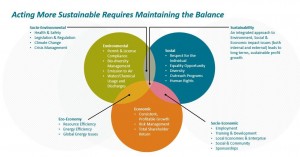This website uses cookies so that we can provide you with the best user experience possible. Cookie information is stored in your browser and performs functions such as recognising you when you return to our website and helping our team to understand which sections of the website you find most interesting and useful.
News
How to Identify Your Brand’s Sustainable Pathway
So you’ve decided to become a more sustainable brand. You’re ready to move beyond such baby steps as purchasing eco-friendly coffee filters and working with green printers to transform into a company that is serious about producing more with less.
Now comes the hard work.
Whether you’re a lone company forging ahead or part of an industry initiative, the first step toward becoming truly sustainable is to identify your path forward.
You need to undertake a materiality assessment.
As discussed in Moving to a More Sustainable Future, a materiality study is a process for obtaining an overall snapshot of how your company or industry is doing in the environmental, social and economy spheres—and where it could do better. The aim of such a study is to identify the “hotspots,” changes (e.g., emissions, wastewater use) you can put in place quickly to have the biggest immediate payback.
First, Map Your Value Chain

There are three main buckets: environmental, economic and social. The first step with any materiality study is to identify the major categories of importance to your company and your industry. Think of this as a spreadsheet with columns for the major steps in your supply chain and rows broken down by category (with items grouped together within that).
As a vinyl resin manufacturer, for example, you might include energy, emissions to air and emissions to water (among other items) within the environmental bucket. You’d certainly include worker health and safety, diversity and impact on communities within the social bucket. In terms of economic impact, you likely would include business ethics, risk management and shareholder return among the items in that bucket.
In addition to your core buckets, different companies and industries may have additional buckets that they need to account for. For example, is value-chain transparency a core category for your business, your industry and/or your stakeholders?
Now Do Your Research
Step 2 in the materiality assessment starts with a literature review. The aim of the literature review is to understand what has been published or is being said by the many stakeholders who know something about your market segment, your product and your industry. Companies undertaking a materiality study will typically look at anywhere from 150-300 different literature sources.
In the vinyl industry, you might start with what scientists, nongovernmental organizations (NGOs), and other key groups are saying about vinyl and sustainability. As a U.S. resin producer, you might want to read research on vinyl as a resin but filter out research about vinyl additives or vinyl production in Europe. As you go through your literature review, you will want to track the hot topics that filter to the top. For example, how many times do people focus on “emissions to air” versus other elements identified in Step 1?
Once you’ve completed your literature review, the next task in Step 2 is to interview key stakeholders. For a vinyl product company, for example, these might include customers, suppliers (e.g., large chemical manufacturers), financial analysts (e.g., people that advise on buying company stock), influential academics, retailers and some NGOs. In addition to giving you fresh insights into how different audiences perceive your business, these interviews will help you to test your “hotspot” assumptions against what others tell you does and doesn’t matter to them.
Regroup Internally
Once you’ve heard what external audiences are saying about you, it’s time to ask what matters most to people across your company. You might find, for example, that although everyone externally ranks “emissions from air” as very important, internally you know you’ve done everything you can for now on that front. That means it’s not your hotspot—but it is something around which you need to communicate better to external audiences what it is you have done to address the issue.
Finally, Pick Your Hotspots
At this point, you should have a 360-degree picture of what different internal and external stakeholders are saying about you, your industry and your value chain. You should have identified the hotspots that matter most to you and those that matter most to various stakeholders. Some of these are likely elements where you can easily develop a plan to move forward. A few are communications challenges (such as, in this example, “emissions to air”). Others might be newly surfaced concerns where you now know that your company—alone or as part of an industry—has work to do and really needs to get started.
A typical materiality study can take anywhere from 3–6 months and should be repeated approximately every 3–5 years. After all, achieving sustainability isn’t about getting to a single result. Rather, it’s an iterative journey to make our planet more livable for all of us for a long time to come.


